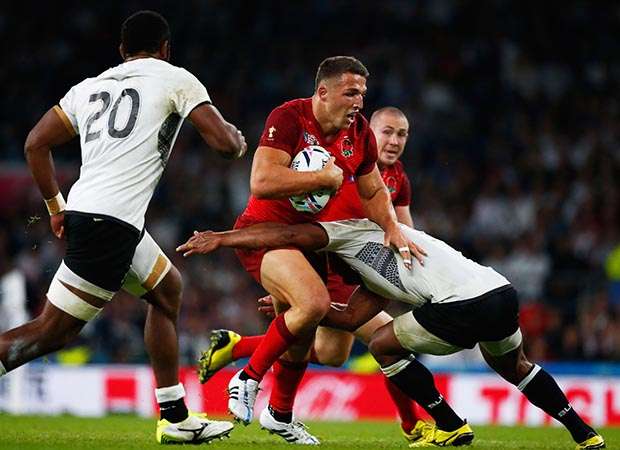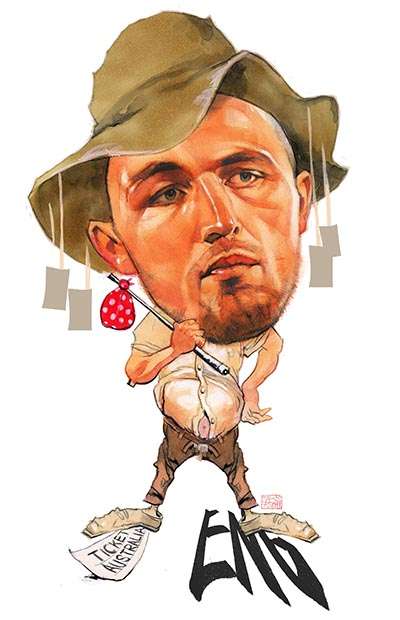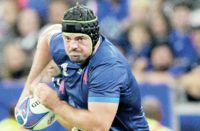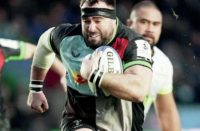 Sam Burgess is the swagman, that's why it's hard to summon huge sympathy for the way his cross-code sortie into Rugby Union has turned out, with strong suggestions this week he intends to leave Bath for a return trip to Sydney. On £500,000 a year Burgess was almost certainly the best paid player England in either Rugby Union or Rugby League, and that sort of earning power means that the green-eyed monster was always likely to be lurking in the recesses of the Union changing rooms he inhabited.
Sam Burgess is the swagman, that's why it's hard to summon huge sympathy for the way his cross-code sortie into Rugby Union has turned out, with strong suggestions this week he intends to leave Bath for a return trip to Sydney. On £500,000 a year Burgess was almost certainly the best paid player England in either Rugby Union or Rugby League, and that sort of earning power means that the green-eyed monster was always likely to be lurking in the recesses of the Union changing rooms he inhabited.
However, while Burgess may have tucked away a tidy sum of swag, there has not been much of the jolly about his 11 months in English Rugby Union – and, should he return to the South Sydney Rabbitohs over the next month or so then Bath and England have plenty to reproach themselves for.
The reality is that everything about Burgess' cross-code move seemed like a rush-job in which the timing was always awry. While his physical and mental toughness was never in doubt – and was reinforced by his decision to play the entire 2014 NRL final with a broken cheekbone sustained in the first minute – Burgess' stint at Bath was full of mixed messages from the start.
Although England coaches Stuart Lancaster and Andy Farrell made the running in brokering Burgess' cross-code adventure, the initial intention was that the big signing from Aussie Rugby League would make a measured transition to the new code at inside-centre in time for the 2019 World Cup.
This process was accelerated at the behest of the England coaches following the injury to Manu Tuilagi, and the need for a replacement with an opposing physical presence ahead of the 2015 World Cup – which Burgess at 6ft 5ins and almost 18 stone provided.
 However, the RFU plan to buy Burgess out of his South Sydney contract hit opposition soon after they had approached a handful of Premiership clubs about his availability. After Bath had declared an immediate interest, their Premiership rivals complained loudly about the unfair practice of the RFU providing finance to one club to make a star signing.
However, the RFU plan to buy Burgess out of his South Sydney contract hit opposition soon after they had approached a handful of Premiership clubs about his availability. After Bath had declared an immediate interest, their Premiership rivals complained loudly about the unfair practice of the RFU providing finance to one club to make a star signing.
With the RFU forced to withdraw from paying the transfer fee for Burgess, the Bath owner, Bruce Craig, was left to pay the transfer in its entirety. This meant that the club were under no obligation to go with the RFU plan, hatched by Lancaster and Farrell, to play Burgess at inside-centre.
This is where the Burgess code-hop started to unravel. It was incumbent on RFU/Lancaster to manage the process so that Burgess was tantamount to a centrally-contracted player if they wanted to give him every chance of succeeding. To do this they should have compensated the other Premiership clubs to the tune of about £150,000 each so that they were not disadvantaged by the Burgess deal with Bath.
In retrospect, it would have been far better had he gone to another Premiership club – perhaps Harlequins or Wasps – specifically as an inside-centre with a brief to be given the ball as much as possible to use his front-on carrying. The sole requirements should have been to crash over the gain-line and either recycle from the tackle, or, once he had acquired the timing and rhythm, to stay on his feet and utilise his off-loading skills out of the tackle.
Initially, the Bath rugby director, Mike Ford, was persuaded to play Burgess at 12, but the plan soon started to lose traction. With Bath having developed a backline based on a relatively intricate ‘diamond formation' attack, and Burgess being a Union novice, he was cast more in the role of a big decoy runner rather than the crash-ball carrier and off-loader Lancaster and co had envisaged.
The situation was complicated further by Bath already having an international 12 in Kyle Eastmond – who had made a successful transition from League already – and a promising youngster in Ollie Devoto. Before long Burgess was playing for the club at outside-centre – which he was clearly not suited to – almost as much at inside-centre, and, understandably, he looked tentative.
As a carrier in League Burgess might make 40 runs a match, and just as many tackles, but at Bath he was getting his hands on the ball barely eight times a match. The lack of action left Burgess in limbo, and by the time he gave a stuttering display at 12 for the England Saxons in a narrow win over the Irish Wolfhounds in January, the fanfare that had played on his arrival in the 15-man code was starting to sound out of tune.
A straightforward brief, and a simple game plan was what Burgess needed – but it did not dovetail with the way Bath rugby director Mike Ford wanted his side to play. This explains why, in April, Ford announced he was switching Burgess to blindside flanker after just 14 matches at centre. He played his first match in the back row in early April, and appeared to enjoy the greater involvement in the rough and tumble.
By the time he played his seventh match at blindside in the Premiership final, apart from the line-out, he appeared to have made good headway. However, whether he was better than Bath's two other imposing blindsides, Matt Garvey and Carl Fearns (now with Lyon) is another matter.
It was all change again for Burgess, when, having been selected by Lancaster in the England long squad in June, he was back at inside-centre. Having trained the house down, Burgess made a solid England debut against France in the first World Cup warm-up game in August.
The trouble started for Burgess in earnest when, on the evidence of just 21 club matches in three different positions for Bath, and a couple of England appearances in warm-up Tests, he was picked ahead of Six Nations starter Luther Burrell, and Eastmond, in the 31-man World Cup squad.
His credentials as a Test inside centre were soon being questioned by a host of former England players – understandably so, given his limited experience with Bath.
Despite Burgess acquitting himself reasonably well in defence against Wales, but then wrecking his performance with a swinging arm tackle that merited a sin-bin after coming off the bench against Australia, the furore surrounding his selection ahead of Burrell grew in volume as England's World Cup went into free-fall.
Burgess is unhappy at being made a scapegoat for that failure – and justifiably so. The accelerated RFU plan to bring him into the England squad was poorly conceived and executed, and premature. Perhaps Burgess' advisers should have asked more pertinent questions about the RFU's plans to fast-track him, but apart from taking the swag on offer he did not short-change either Bath or England. Instead, it was he who was short-changed.


























